
A dry dock is a narrow basin or vessel that can be flooded to allow a load to be floated in, then drained to allow that load to come to rest on a dry platform. Dry docks are used for the construction, maintenance, and repair of ships, boats, and other watercraft.

HMAS Encounter was a second-class protected cruiser of the Challenger class operated by the Royal Navy (RN) and Royal Australian Navy (RAN). She was built by HM Dockyard Devonport and completed at the end of 1905.

Cockatoo Island Wareamah is a UNESCO World Heritage Site at the confluence of the Parramatta River and Lane Cove River in Sydney Harbour, New South Wales, Australia.

Garden Island is an inner-city locality of Sydney, Australia, and the location of a major Royal Australian Navy (RAN) base. It is located to the north-east of the Sydney central business district and juts out into Port Jackson, immediately to the north of the suburb of Potts Point. Used for government and naval purposes since the earliest days of the colony of Sydney, it was originally a completely-detached island but was joined to the Potts Point shoreline by major land reclamation work during World War II.

The Cockatoo Island Dockyard was a major dockyard in Sydney, Australia, based on Cockatoo Island. The dockyard was established in 1857 to maintain Royal Navy warships. It later built and repaired military and battle ships, and played a key role in sustaining the Royal Australian Navy. The dockyard was closed in 1991, and its remnants are heritage listed as the Cockatoo Island Industrial Conservation Area.

Marine salvage is the process of recovering a ship and its cargo after a shipwreck or other maritime casualty. Salvage may encompass towing, lifting a vessel, or effecting repairs to a ship. Protecting the coastal environment from oil spillages or other contaminants from a modern ship can also be a motivator, as oil, cargo, and other pollutants can easily leak from a wreck.

HMAS Torrens, named for the River Torrens, was a River-class torpedo-boat destroyer of the Royal Australian Navy (RAN). The destroyer was built at Cockatoo Island Dockyard and entered service with the RAN in 1916. The destroyer was first deployed to East Asia, then the Mediterranean, where she remained for the rest of World War I. After returning to Australia, the destroyer was decommissioned, but saw use in several ports for reservist training before the decision to sell her for scrap was made. After being stripped, the destroyer was towed outside Sydney Heads, used for gunnery practice, and scuttled.

A crane vessel, crane ship, crane barge, or floating crane is a ship with a crane specialized in lifting heavy loads, typically exceeding 1,500 t for modern ships. The largest crane vessels are used for offshore construction.
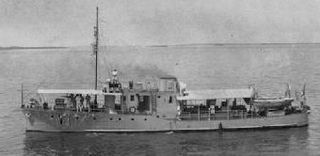
HMAS Vigilant was an auxiliary patrol boat serving with the Royal Australian Navy during the Second World War. Notably it was the 120th ship built by the Cockatoo Island Dockyard and the first aluminium ship built in Australia.
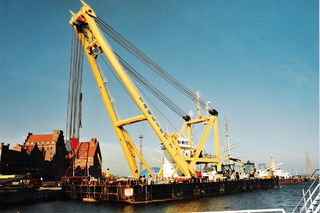
A floating sheerleg is a floating water vessel with a crane built on shear legs. Unlike other types of crane vessel, it is not capable of rotating its crane independently of its hull.
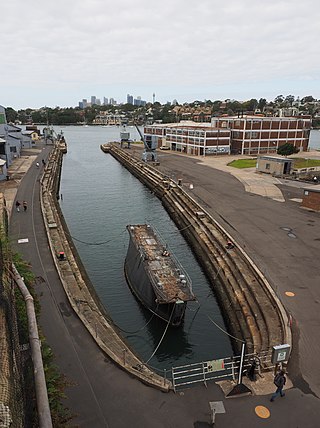
Fitzroy Dock is a heritage-listed dockyard at the former Cockatoo Island Dockyard, Cockatoo Island, Sydney Harbour, New South Wales, Australia. It was added to the Australian Commonwealth Heritage List on 22 June 2004.
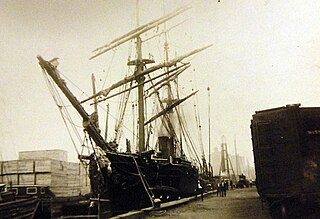
HMS Pelican was an Osprey-class sloop built for the Royal Navy in the mid-1870s. She was launched in 1877 and was sold to the Hudson's Bay Company in 1901. She was scuttled in 1953.

Bellubera was a ferry operated by the Port Jackson & Manly Steamship Company on the Manly service. Launched in 1910, she was the third of six "Binngarra-type" vessels. Upon her 1936 conversion from steam power, she became the first diesel-electric vessel in Australia. She was decommissioned in 1973, and scuttled at sea in 1980.
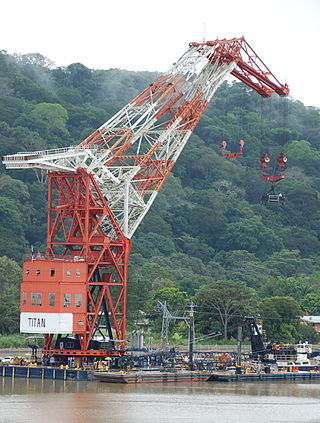
Titan, better known by its former nickname Herman the German, is a large floating crane currently serving in the Panama Canal performing heavy lifts for lock maintenance. Prior to its move to Panama in 1996, the crane was based at the Long Beach Naval Shipyard from the end of World War II until the yard's closure in 1995. It was seized from the German Kriegsmarine following the end of World War II as part of war reparations. The crane was built by Demag Cranes AG as Schwimmkran nr. 1 in 1941 for the Kriegsmarine, where it had served in the Baltic Sea tending German U-boats. MMSI number: 374940000

Commonwealth Lightship 4 (CLS4) Carpentaria is a lightship that was in service from 1917 to 1985 with the Commonwealth Lighthouse Service, built at the Cockatoo Island Dockyard and commissioned in 1917. The vessel is named after the Gulf of Carpentaria, where it spent most of its service life together with its sister ship CLS2.

Langer Heinrich, or in English Long Henry, is a floating crane commissioned in 1915 for the Wilhelmshaven Imperial Shipyard in Wilhelmshaven, Germany and has been located in Genoa, Italy since 1997. At the time of completion she was the largest floating crane in the world, passing up the Ajax crane barge completed in 1914.

Cockatoo Island Industrial Conservation Area is a heritage-listed protected area relating to the former Cockatoo Island Dockyard at Cockatoo Island, Sydney Harbour, New South Wales, Australia. It was added to the Australian Commonwealth Heritage List on 22 June 2004.

A block-setting crane is a form of crane. They were used for installing the large stone blocks used to build breakwaters, moles and stone piers.

The Garden Island Naval Precinct is a heritage-listed naval base and defence precinct located at Cowper Wharf Roadway in the inner eastern Sydney neighbourhood of Garden Island, New South Wales, Australia. The precinct was built from 1856. It includes the HMAS Kuttabul naval base, formerly known as HMAS Penguin. The property is owned by Australian Department of Defence. It was added to the Commonwealth Heritage List on 22 June 2004 and the New South Wales State Heritage Register on 12 November 2004.
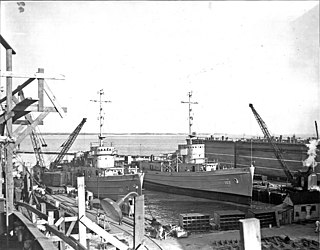
USS Hidatsa (ATF-102) was Abnaki-class tugboat during the World War II. The ship was later sold to Colombia as ARC Rodrigo de Bastidas (RM-74). Her namesake is an Indian group of the Sioux Tribe of North Dakota, now living on the Fort Berthold Reservation.





















